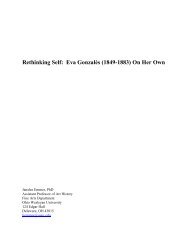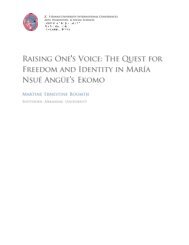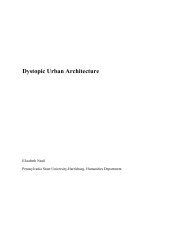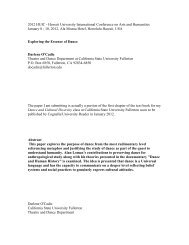Lieder eines armen Mädchens: a Song Cycle for the Cabaret ...
Lieder eines armen Mädchens: a Song Cycle for the Cabaret ...
Lieder eines armen Mädchens: a Song Cycle for the Cabaret ...
Create successful ePaper yourself
Turn your PDF publications into a flip-book with our unique Google optimized e-Paper software.
<strong>the</strong> situation and react in <strong>the</strong>ir own way both in <strong>the</strong> <strong>the</strong>ater and in <strong>the</strong>ir subsequent<br />
actions.<br />
Struve 7<br />
Ano<strong>the</strong>r <strong>the</strong>me that permeates <strong>the</strong> <strong>Lieder</strong> <strong>eines</strong> <strong>armen</strong> <strong>Mädchens</strong> is an obsession<br />
with death, and <strong>the</strong> hope that comes in heaven. The texts frequently present this<br />
pa<strong>the</strong>tic creature from a perspective that offers little hope <strong>for</strong> redemption or escape in<br />
this world. The reality of her life is one of poverty and suffering, and because she never<br />
complains about <strong>the</strong> unfairness of her situation, <strong>the</strong> acceptance of her existence and her<br />
resignation to <strong>the</strong> idea that a better life will only be possible in heaven enhance <strong>the</strong><br />
tragic nature of <strong>the</strong> character. The character’s life circumstances are dismal, without<br />
hope <strong>for</strong> redemption or escape except through death.<br />
“Wenn ick mal tot bin” (“When I am dead”) is <strong>the</strong> most obvious example of <strong>the</strong><br />
child’s positive outlook towards death. The young girl describes her funeral, remarking<br />
how beautiful she will look, how all her friends and relatives will ga<strong>the</strong>r and mourn, and<br />
finally how she will be welcomed in heaven. In <strong>the</strong> third verse, Lieschen explains:<br />
When I am dead, <strong>the</strong>y light candles with yellow flames<br />
They put <strong>the</strong>m right and left of me, very close,<br />
Then a golden light falls on my diseased bones<br />
And our teacher, he begins to cry terribly!<br />
Only aunt is very happy, when I am dead<br />
When I am dead, I don’t eat anymore. 8<br />
This verse also offers a prime example of Hollaender’s ability to balance comedy with<br />
tragedy. The childlike innocence in <strong>the</strong> image of <strong>the</strong> funeral offers a kind of morbid<br />
humor, given <strong>the</strong> casual and direct way in which <strong>the</strong> child presents visions her death and<br />
8 Text found from <strong>the</strong> manuscript copy found in <strong>the</strong> Deutsches Kabarett-Archiv, Mainz,<br />
Germany. Original music is <strong>the</strong> property of <strong>the</strong> estate of Blandine Ebinger. Translation<br />
by Jonathon Struve and Jute Anderson.







